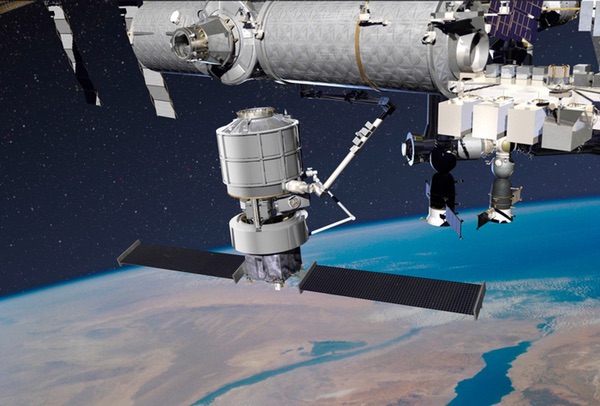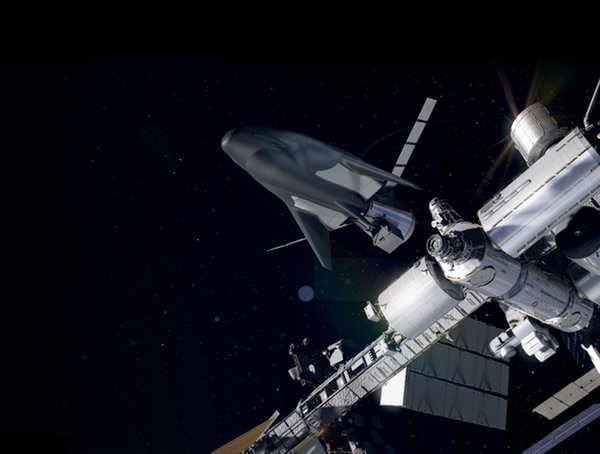For commercial cargo, ideas old and newby Jeff Foust
|
| While Orbital and SpaceX might have the inside edge given their work on CRS and NASA’s earlier COTS investment, it has not stopped at least three other companies from bidding on CRS-2. |
Those cargo contracts, now essential for maintaining the ISS, will soon run out, although NASA plans to give extensions to Orbital and SpaceX to cover missions into 2017. Last fall, the agency issued a request for proposal for Commercial Resupply Services 2 (CRS-2) contracts, a follow-on to the current CRS contracts. Proposals were due to NASA in December, with contracts—at least two—to be awarded by June.
While Orbital and SpaceX might have the inside edge given their work on CRS and NASA’s earlier COTS investment, it has not stopped at least three other companies from bidding on CRS-2. In December, Boeing, a winner of a commercial crew contract last September, said it had bid on CRS-2 using a version of its CST-100 crew spacecraft (see “In with the new, and the old”, The Space Review, January 5, 2015). Earlier this month, two other competitors offered details about their commercial cargo proposals.
SNC chases the CRS-2 dream
Sierra Nevada Corporation (SNC) had indicated from the beginning of the CRS-2 competition that it planned to submit a bid, even as it protested the NASA commercial crew contracts awarded to Boeing and SpaceX. With that protest dismissed in January by the Government Accountability Office, much is now riding on SNC’s CRS-2 bid.
The company formally unveiled its CRS-2 concept at a press conference in Washington on March 17, tied to the Satellite 2015 conference taking place there. “We have been working on Dream Chaser now for about nine years,” said Mark Sirangelo, corporate vice president of SNC and head of its space systems division. “We have created a very strong and, we think, very competitive and capable vehicle as a baseline.”
As expected, SNC’s concept is derived from that baseline Dream Chaser vehicle, but with two significant changes. One is the addition of a cargo module mounted to the aft section of Dream Chaser that can accommodate additional cargo both internally and externally. The other is to allow the vehicle’s wings to fold so that it can fit within a payload fairing five meters in diameter, allowing it to be launched by either an Atlas V or Ariane 5, among other vehicles. (The crew version of Dream Chaser planned to launch on an Atlas V without a payload fairing.)
As envisioned by SNC, the vehicle, formally known as the Dream Chaser Cargo System, would dock with the ISS using a port on the new cargo module. At the end of its stay on the ISS, it would be loaded with cargo and undock. The cargo module would separate and burn up on reentry, allowing for the disposal of trash. Dream Chaser itself would glide to a runway landing, allowing for the return of experiments and other cargo.
| “This continues to be a multi-mission vehicle, and enables and preserves a path to provide a crew vehicle as well,” Sirangelo said. |
Sirangelo argued that this concept met all of NASA’s needs: transportation of both pressurized and unpressurized (external) cargo to the station, as well as the disposal of trash from the station and the return of cargo to Earth. It also meets or exceeds the “upmass” and “downmass” requirements in NASA’s CRS-2 request for proposals. The system can transport 5,500 kilograms of cargo to the ISS, and bring down 5,000 kilograms, 1,750 kilograms back to Earth and 3,250 kilograms of disposal.
“In our design thinking, we needed to, in our view, do this with one system and one vehicle, and within one mission profile, and we believe we’ve done that,” Sirangelo said.
Beyond the addition of the cargo module and the foldable wings, SNC has made only minor changes to the Dream Chaser vehicle, Sirangelo said. Those changes include stripping out the “human factors” items inside the spacecraft needed to support crews, in order to maximize the amount of cargo it can carry. The company has also made minor changes to the thermal protection system and other subsystems as part of the overall maturation of the Dream Chaser design.
This focus on a cargo vehicle, though, doesn’t mean that the company has given up on a crewed version. “This continues to be a multi-mission vehicle, and enables and preserves a path to provide a crew vehicle as well,” Sirangelo said. The company is still working on the last milestone of its prior commercial crew award from NASA, a second drop test of a Dream Chaser engineering prototype. That test is planned for late this year, he said.
SNC didn’t discuss costs to develop or operate the cargo version of Dream Chaser; NASA’s CRS-2 contracts will only cover the operational missions and don’t include a COTS-like effort to fund vehicle development. The company instead emphasized the Dream Chaser’s unique capabilities, including its ability to land on a runway, unlike competing capsule designs. “There are many capsules in the world. There’s really only one vehicle like Dream Chaser,” Sirangelo said. “We believe a mixed fleet.”
 A Jupiter spacecraft, with an Exoliner cargo module attached, berths with the International Space Station. (credit: Lockheed Martin) |
Lockheed Martin boards the railroad
SNC’s unveiling of the cargo version of Dream Chaser came less than a week after another company offered the public a first look at its cargo concept. Unlike other companies, Lockheed Martin has neither an existing commercial cargo vehicle, or has done work on a commercial crew vehicle. While some speculated that the company might offer a variant of the Orion spacecraft it’s developing for NASA’s exploration program, the company instead has gone in a very different direction.
Lockheed’s concept consists of two different vehicles. One, called Jupiter, is a space tug, equipped with propulsion systems and a robotic arm. The other, Exoliner, is a version of the cargo contained used by Europe’s Automated Transfer Vehicle (ATV) to carry cargo to the ISS. In a train metaphor used by the company at the March 12 press event (held at Washington’s Union Station), Jupiter is a locomotive while Exoliner is a railcar.
Lockheed Martin would start cargo services by launching a Jupiter and Exoliner together on an Atlas V. That vehicle would berth with the station with the assistance of the station’s robotic arm, in much the same way as Cygnus and Dragon cargo spacecraft do today. After unloading up to 5,000 kilograms of cargo and then loading cargo for disposal, Jupiter and Exoliner would unberth from the ISS and move away.
Rather than reentering immediately, though, the two spacecraft would remain in orbit for weeks or months. During that time, it could carry out additional missions, such as launching small satellites or performing remote sensing observations with hosted sensors.
| “The expensive part of this system stays in orbit and is reused on every mission,” said Crocker, offering considerable savings. “You can put a number to it, and it’s not small.” |
Later, an Atlas V would launch just an Exoliner filled with cargo. The Jupiter and the old Exoliner then meets up with the new Exoliner, still mated to its Centaur upper stage. Jupiter would then use its robotic arm to swap Exoliner modules, grabbing the new module for transport to the ISS while attaching the old one to the Centaur, which would then fire its engine to reenter.
The concept looks brand new, but Lockheed Martin officials emphasized the flight heritage of its various components. “You have to have a design that has proven systems” to make both investors and customers comfortable, said Wanda Sigur, vice president and general manager of Lockheed Martin Space Systems Civil Space line of business. “A solution that includes design reuse.”
Jupiter is based on hardware that has flown on a number of Lockheed Martin spacecraft, including the MAVEN Mars orbiter. Canada’s MDA is providing the robotic arm based on its past work on shuttle and station robotics, while Thales Alenia Space is providing the Exoliner cargo module that is derived on the one it built for the ATV.
One advantage of this architecture, company officials argued, was cost. “The expensive part of this system stays in orbit and is reused on every mission,” said Jim Crocker, vice president and general manager of Lockheed Martin Space Systems International. Jupiter, he said, contains avionics and sensors, among other subsystems that don’t need to be purchased for every cargo flight, saving money. “You can put a number to it, and it’s not small.” Crocker, though, did not put a number to the cost savings offered by reusing Jupiter.
The system can also be used for other applications beyond ISS cargo transfer. One obvious application hinted at in the Lockheed Martin briefing is satellite servicing: the same ability to rendezvous with and manipulate vehicles that Jupiter provides could be repurposed for repairing or refueling spacecraft.
The company emphasized the role that Jupiter and Exoliner could play in supporting cislunar human spaceflight. Lockheed Martin space architect Josh Hopkins said a Jupiter/Exoliner stack could be launched with an Orion on a Block 1 version of NASA’s Space Launch System, acting as a logistics and habitat module. “When you dock Orion to one of these, you triple the living space for the astronauts,” he said.
Jupiter and Exoliner could also serve as the building block for an outpost at the Earth-Moon L1 point or distant retrograde lunar orbit. Hopkins said the system could be launched independently of SLS as a primary payload on a commercial vehicle.
“We’re unveiling a solution that goes beyond the space station, a solution that will allow us to set the stage for a revolution in the commercial exploration with NASA of first LEO, and then beyond,” Crocker said, emphasizing the public-private partnership nature of ISS cargo resupply and linking it to the development of the transcontinental railroad (Jupiter was named after one of the locomotives that met at Promontory, Utah, in 1869 to mark the completion of that railroad.)
NASA, though, will judge these and other systems primarily on their ability to transport cargo to and from the ISS. For all the discussion of extending human spaceflight, and commercial’s role in that, beyond LEO, these systems must first demonstrate the ability to keep that one current outpost in Earth orbit adequately supplied to enable those future steps.
